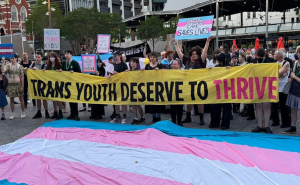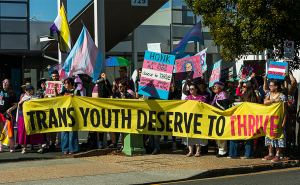
Given all the contradictory expectations we have for clothes, it’s easy to get your kickers in a twist, but finding the right clothes as a non-binary person challenges those expectations.
Clothes are a barrier between our bodies and the outside world, shielding us from temperatures and spiky things.
But they also represent our inner selves to others, projecting our internal world outward. In this way, clothes turn us inside out; concealing our bodies while revealing our personalities.
Dr Antimony Deor unpacks the complexities of fashion choices for non-binary people
A person’s fashion choices can offer a glimpse into their character – but that character can be fictional. The right outfit can craft the image of a suave professional, sensible pragmatist, or quirky creative, no matter how slobby, whimsical or boring the wearer might actually feel.
Some people use fashion to broadcast their inner self, while others prefer to remain a clothed book.
This can make fashion complicated for non-binary people.
For us, there’s often a huge difference between the way we look on the outside and how we feel on the inside.
Wardrobes can be a portal to a magical new world, or just another place to hide your skeletons.
Pulling it off
With all the self-consciousness and doubt that come with being non-binary, and how paralysing this anxiety can be, it’s lucky we have clothes to fall back on. It’s also illegal to be naked in public, so fashion can only be avoided for so long.
In the same way that there’s a nebulous pressure for women to look womanly and men to look manly, there’s an idea that non-binary people should also dress according to their gender, or lack thereof.
But what does a non-binary person look like?
Androgyny is actually really hard to achieve for most people, while a blended expression of masculine and feminine styles is likely to get you beaten up in some places. And that’s if you can even find anything that fits!
I’ve always loved clothes, but after I came out as non-binary I started to overthink them.
It was easy to get caught up in what other people might think, rather than what was comfortable or made me happy.
Ideally, I wanted my friends to perceive me as a more vivid version of myself, but for my parents to not notice any change at all.
I wanted other trans people to be able to recognise me, but for everyone else to see me as unremarkably androgynous. This was a lot to ask from a pair of pants.
Heart on my sleeve
I was in my late 30s when I started medically transitioning, and had built up an impressive wardrobe of 70s pantsuits, pretentious jackets, and opshop specials. But as my body changed shape, my clothes didn’t.
Before I could see the changes of hormone replacement therapy, I could feel them in the way that clothes fit.
Shirts became tighter around my stomach and trousers looser on my thighs. It started to feel more comfortable to wear collars unbuttoned and pants lower on my hips.
Higher haemoglobin meant my pale skin became rosy, changing the colour palette that suited my complexion. A faster metabolism and higher body temperature put an end to wearing anything with sleeves between November and March.
After top surgery but before the cost of living crisis, I bought tight shirts and mesh tops to show off my beautiful chest. I’d never had any trouble finding women’s clothes that fit. It was a different story when I ventured into the male section.
Boy’s clothes fit, but men’s didn’t. They say transition is like a second puberty, but I wasn’t expecting it to be literal.
I tried to avoid looking like a 37-year-old tween, but it was difficult when Dragonball Z tshirts were the only thing that fit.
Common threads
Exploring gender through fashion can be a fun opportunity to try out some new looks, but also expensive and frustrating.
Like everything else in the world, clothes don’t have to be gendered, but they are.
Even if I had the money to buy a whole new wardrobe, that wouldn’t stop people making assumptions about my body.
Clothes are made to fit an idealised male or female shape, but designs also exaggerate sex differences. Men’s and women’s fashion overlay us with a boxy rectangle or curvy hourglass, which only roughly corresponds to the unique body underneath.
In becoming a curvy rectangle, I joined a community of people who were too tall, too small, too large, too disabled or too unconventionally proportioned to fit into mainstream fashion.
In my non-binary shoes
Writing about clothes is like making sculpture about poetry.
An outfit makes its own statement – hopefully more elegant than the ones I’ve written here.
I’m used to being the support for clothes, but clothes have actually supported me on my gender journey, both as armour and mirror to the material reality of being non-binary in this world.



